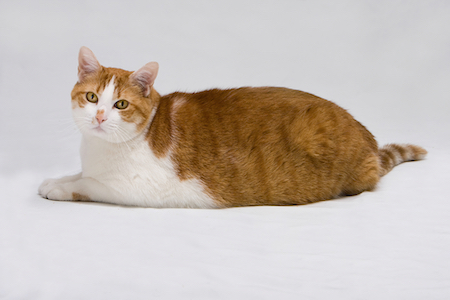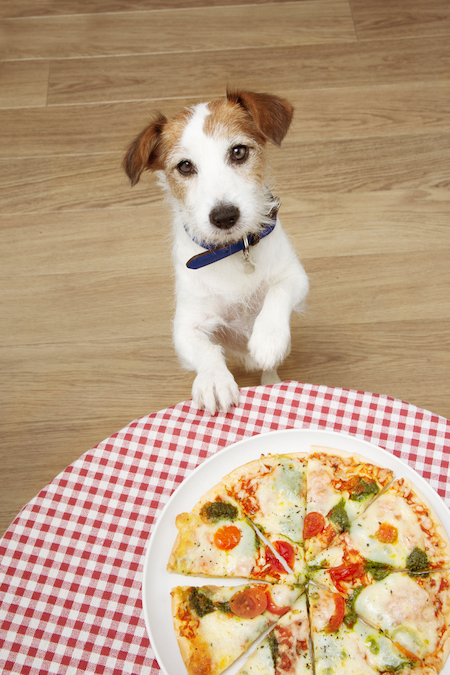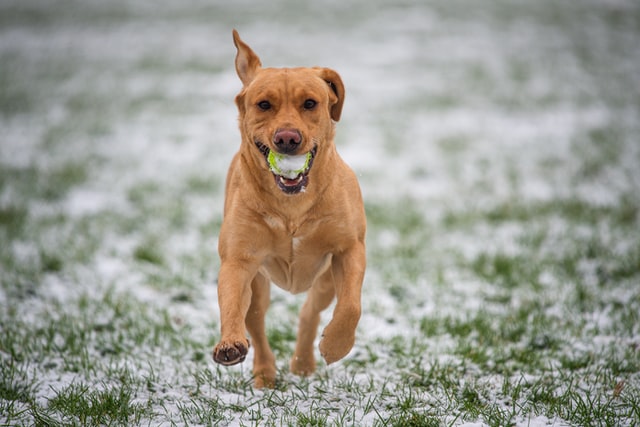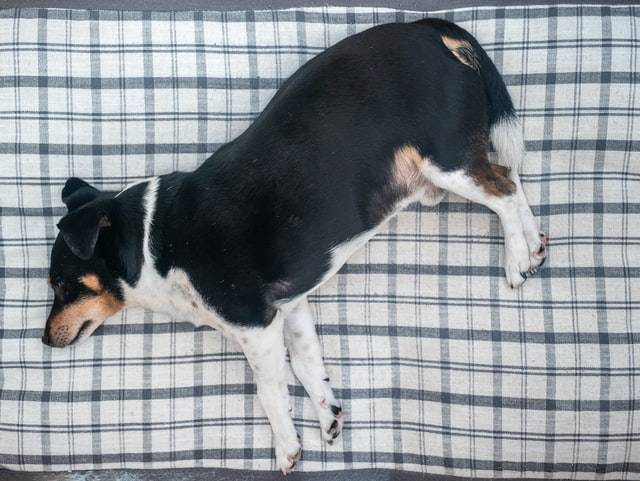5 Tips to Prevent Pet Obesity
Posted: 11/06/2023 | BY: Erin Cain | Categories: Uncategorized
Just like their pet parents, pets are susceptible to developing excess body fat and becoming obese. Pet obesity leads to a series of other serious medical conditions, including diabetes, inflammation and degenerative joint disease, cardiovascular disease, high blood pressure, kidney disease and various cancers. Not only is the treatment and management of these illnesses costly, but they may also shorten your pet’s lifespan by up to 2 ½ years. How can you prevent pet obesity in your furkids? Here are four manageable ways you can change your pet’s lifestyle to prevent pet obesity and help your furkid live a longer, healthier life.

1. Know what and how much food your pet should eat daily.
Life is busy, and it’s sometimes easier to just fill the dog’s bowl with a couple cups of kibble or open more than one can of wet food for your cat before you run out the door. Unfortunately, pet parents often unwittingly feed their pets unhealthy food and more of it than their pet needs.
Pets require a different number of calories, proteins, vitamins and minerals depending on their age, breed, development and health. Unfortunately, feeding your dog or cat the wrong kind of food that does not provide nutritious value, or food filled with cheap, processed sugars, fillers, and harmful additives, can cause them to gain weight and become ill over time. Talk with your veterinarian if you are unsure what food is best for your pet or if you don’t know how much to feed them. Additionally, you can reference the feeding guide located on the back of the bag or box of pet food that you use.

2. Stop feeding your pet table scraps and human food.
Look, the struggle is real. We’ve all been there as pet parents. You’re eating your tasty hamburger and fries at the table while your loyal, beloved dog stares unwaveringly at each bite you take with pleading eyes. It’s all too easy to rationalize giving your dog or cat leftovers or scraps from dinner. After all, what’s the harm in giving part of a burger to your best four-legged friend?
Sadly, there is significant physical harm done when you feed scraps to your pets on more than rare occasions. Your pet already eats her food each day; adding extra calories will add up faster than you think. For example, one ounce of cheddar cheese fed to a 20-lb. dog is equal in calories to 1½ hamburgers! Yes, those tidbits do add up, so let your pet eat her pet food and keep your human food on your plate.

3. Feed your pets healthy treats.
It’s all too easy to buy a cheap bag of dog treats and experience a thrill when our dog or cat happily gobble them down. However, the reason why our pets love those treats has everything to do with sugar and sodium and nothing to do with health. They’re the equivalent of potato chips for people. Many commercial pet treats have the same amount of calories as a cup of kibble, which means those calories (and pounds) add up fast.
Change things up for your pet by treating them with foods they will like that are healthy snacks. Try healthy treats such as raw baby carrots, broccoli florets, pureed pumpkin, or apple slices. Cats love catnip, which is an inexpensive and natural treat for them that doesn’t add weight. If you have a talent for cooking, make healthy homemade treats. Then you can feel extra good when your pet wolfs down a treat that is equally good for her.

4. Make exercise and play a pet priority.
One of the fastest ways to get your pet back in shape is through exercise. Don’t focus so much on how long your pet should exercise daily, but more on what types of activities are suitable for her species, breed, age, and health. A veterinarian can work with you to craft a weight loss and exercise plan that allows your pet to build up her muscles while losing weight at a safe speed.
In general, dogs should receive 30-minutes of daily physical exercise. Make it fun for you and your pup by engaging in different activities, from walking to ball retrieving to chasing squeaky toys or swimming. A cat needs three 5-minute intense daily exercise sessions, so grab that feather wand or laser pointer, and awaken your cat’s inner predator to get her moving and avoid weight gain.

5. Take your pet for vet checkups every year.
An easy way to keep track of your pet’s well-being is to take her for her annual veterinary checkup. Just as people need annual physicals to gauge their health, pets need a record of their medical history as well. Regular yearly check-ups mean your veterinarian has a much better chance of noticing potential health issues, such as weight gain, before too much damage is done.
Because it is hard for some pet parents to know if their pet is overweight, having a veterinarian examine and assess your pet’s weight and overall health is essential for a pet’s health and happiness.
Keep the extra pounds off your pet.
Pet obesity is preventable, so if your pup or kitty is a little chunkier than they should be, don’t despair. Your veterinarian can help you get your pet back on the right track. The above suggestions are good starting points to make your pet’s health and weight a priority. If your pet’s insurance policy includes wellness coverage, the policy may cover your pet’s vet visits, care, and therapy. Don’t have pet insurance? No worries! Get a free quote for your pet today and commit to your furkid’s current and future health.
References:
- Ward, E. (2017). Beyond the Belly: The health consequences of pet obesity. Retrieved from https://www.veterinarypracticenews.com/beyond-the-belly-the-health-consequences-of-pet-obesity/
- American Veterinary Medical Association. (2019). Study finds overweight dogs live shorter lives. Retrieved from https://www.avma.org/javma-news/2019-03-01/study-finds-overweight-dogs-live-shorter-lives
- Mahaney, P. (2021). Pet Food: The Good, the Bad, and the Healthy. Retrieved from https://www.petsafe.net/learn/pet-food-the-good-the-bad-and-the-healthy
- Bauhaus, J. (2020). Dogs & Table Food: Why to Avoid Feeding Them Scraps. Retrieved from https://www.hillspet.com/dog-care/nutrition-feeding/can-dogs-eat-table-food-or-scraps
- Khuly, P. (2021). Dr. Khuly’s Top Nine Healthy Treat Alternatives for Overweight Pets. Retrieved from https://www.embracepetinsurance.com/waterbowl/article/healthy-treat-alternatives-for-overweight-pets
- Teller, L. (2019). Feline Fine: The Benefits of Catnip. Retrieved from https://vetmed.tamu.edu/news/pet-talk/feline-fine-the-benefits-of-catnip/
- Morris, C. (2019). Homemade Puppy Treats DIY Recipes for Healthy Puppy Treats. Retrieved from https://www.thelabradorsite.com/homemade-puppy-treats/
- Ward. E. ( 2015). The 5 Biggest Questions You Must Ask About Pet Obesity. Retrieved from https://petobesityprevention.org/news/2015/10/19/the-5-biggest-questions-you-must-ask-about-pet-obesity-how-to-check-what-to-feed-and-how-to-exercise
- Handicapped Pets. (n.d.). Benefits of an Annual Checkup for Your Pet. Retrieved from https://www.handicappedpets.com/blog/annual-checkup-is-beneficial-for-your-pet/
- Jones, Sally. (2021). Pet Wellness Plans: Manage Your Preventative Vet Bills. Retrieved from https://www.caninejournal.com/pet-wellness-plans/
Disclaimer
The information contained on this blog is intended for informational and educational purposes only and should not be construed as medical advice. It is not a substitute for professional veterinary care. Always consult with your veterinarian before making any changes to your pet's health care or treatment plan.
The authors of this blog are not veterinarians and do not claim to be experts in pet health. The information provided here is based on our own experiences and research, as well as information from reputable sources. However, we cannot guarantee the accuracy or completeness of this information.
We encourage you to do your own research and consult with your veterinarian before making any decisions about your pet's health.
Previous post
Can Your Pet Get COVID?Compare top pet insurance providers plans.
Enter your dog’s age in years and months to calculate their age equivalent to human years.
Calculate your dog’s ageEnter your cat’s age in years and months to calculate their age equivalent to human years.
Calculate your cat’s age